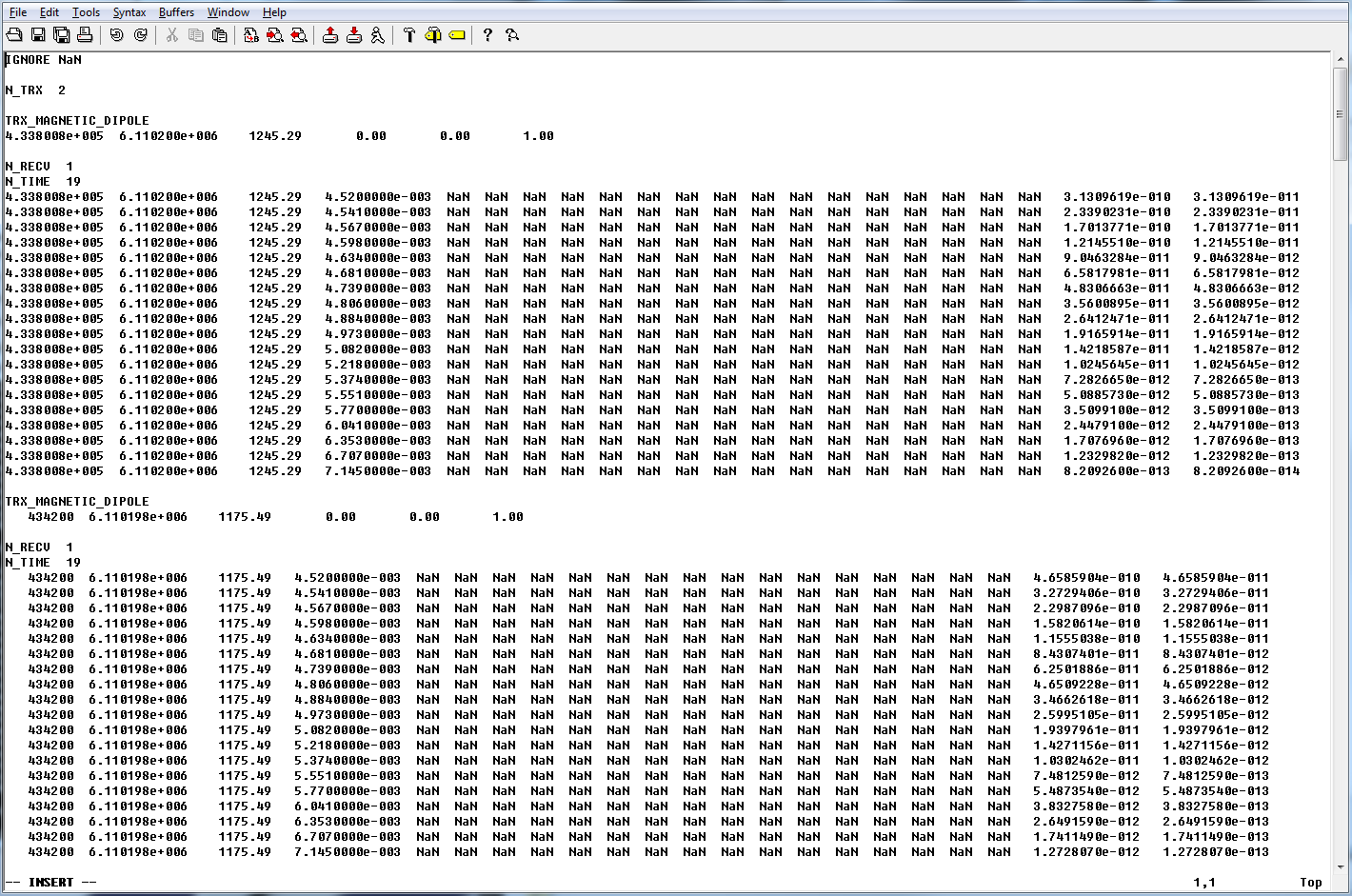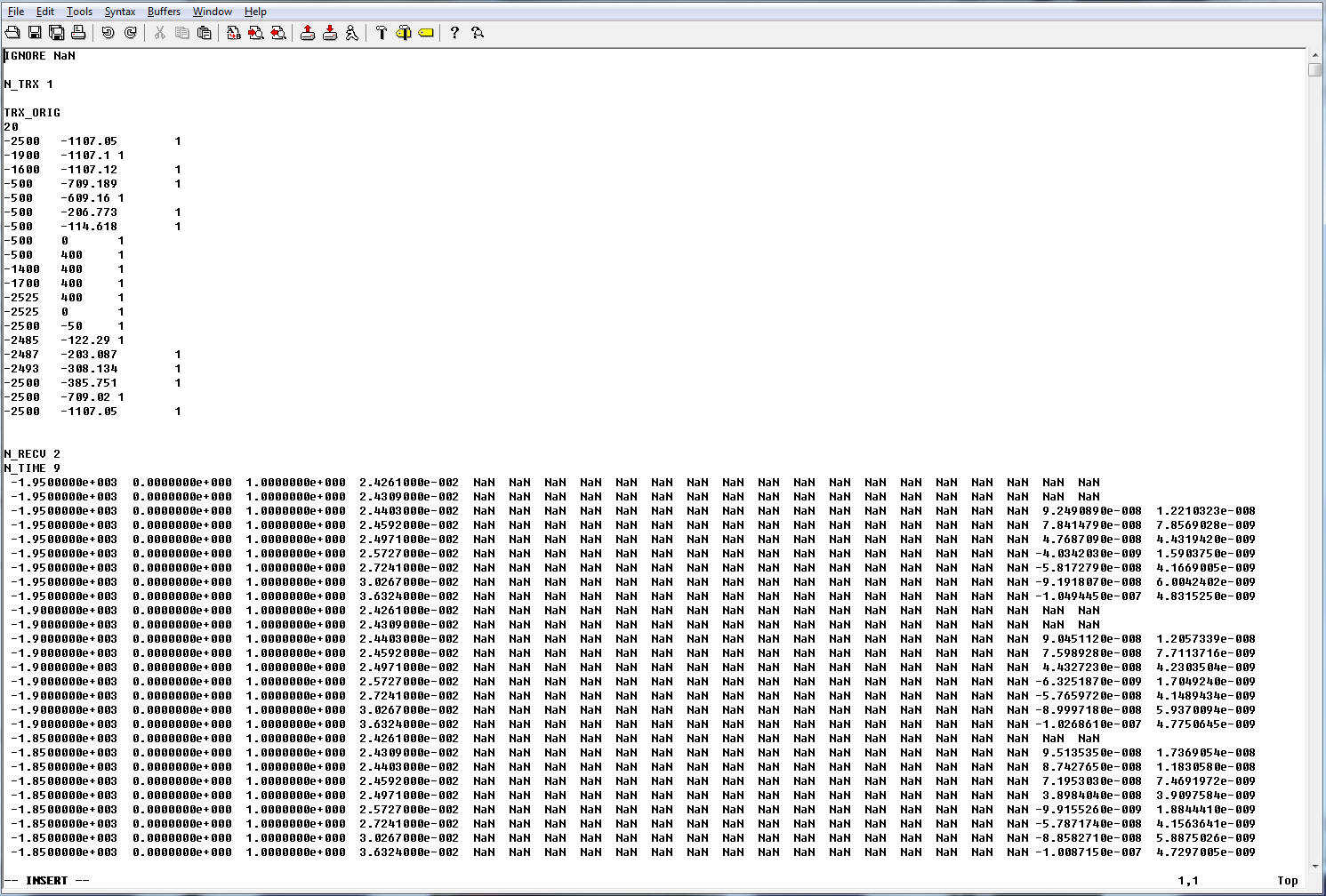5.1.15. TEM data: GIF file
This file is used to specify the transmitters and associated data for a Time-domain ElectroMagnetic (TEM) survey. The file is broken down based on the transmitters and requires all data types be present (although they may be filled with an ignore value; see below). The convention is z+down and x+ East and y+ North. Comment lines begin with !. The data line contains 27 columns (x, y, z, E, H, and dB/dt data with uncertainties), but may be filled with ignore flags to denote using only certain data types. Below is the general format:

Parameter definitions:
flg: Any string/value that does not contain actual data. By default, GIFtools will exportNaNas the ignore value. The flagIGNOREpreceeds this input.ntx: Number of transmitters. The flagN_TRXpreceeds this input.TRX_FLAG: The \(i^{th}\) transmitter. This line contains the specific transmitter flag and block defining the transmitter. See GIF EM transmitters for specifications on formatting different transmitters.nRec: Number of receivers for the \(i^{th}\) transmitter. The flagN_RECVpreceeds this input.nTime: The number of time channels for the \(j^{th}\) receiver associated with the \({i^{th}\) transmitter. The flagN_TIMESpreceeds this input.\(X_{[i,j,k]}\): Easting (m) of the \(j^{th}\) receiver at the \(k^{th}\) time for the \(i^{th}\) transmitter.
\(Y_{[i,j,k]}\): Northing (m) of the \(j^{th}\) receiver at the \(k^{th}\) time for the \(i^{th}\) transmitter.
\(Z_{[i,j,k]}\): Elevation (m) of the \(j^{th}\) receiver at the \(k^{th}\) time for the \(i^{th}\) transmitter.
\(Time\): Time (sec) of the observation.
Edata: 6 columns containing electric-field data aligning with the cartesian coordinate system and their uncertainties \(j^{th}\) receiver at the \(k^{th}\) time for the \(i^{th}\) transmitter (in order):\(Ex\): Electric-field component in the Easting direction.
\(Ex_{stn}\): Standard deviation of the electric-field component in the Easting direction. This must be a positive, non-zero number.
\(Ey\): Electric-field component in the Northing direction.
\(Ey_{stn}\): Standard deviation of the electric-field component in the Northing direction. This must be a positive, non-zero number.
\(Ez\): Vertical component of the electric-field.
\(Ez_{stn}\): Standard deviation of the vertical component of the electric-field. This must be a positive, non-zero number.
Hdata: 6 columns containing magnetic-field data aligning with the cartesian coordinate system and their uncertainties \(j^{th}\) receiver at the \(k^{th}\) time for the \(i^{th}\) transmitter (in order):\(Hx\): Magnetic-field component in the Easting direction.
\(Hx_{stn}\): Standard deviation of the magnetic-field component in the Easting direction. This must be a positive, non-zero number.
\(Hy\): Magnetic-field component in the Northing direction.
\(Hy_{stn}\): Standard deviation of the magnetic-field component in the Northing direction. This must be a positive, non-zero number.
\(Hz\): Vertical component of the magnetic-field.
\(Hz{stn}\): Standard deviation of the vertical component of the magnetic-field. This must be a positive, non-zero number.
dBdTdata: 6 columns containing \(\partial B / \partial t\) data aligning with the cartesian coordinate system and their uncertainties \(j^{th}\) receiver at the \(k^{th}\) time for the \(i^{th}\) transmitter (in order):\(\partial B / \partial t_x\): Derivative the B-field in the Easting direction.
\(\partial B / \partial t_x^{stn}\): Standard deviation of the derivative the B-field in the Easting direction. This must be a positive, non-zero number.
\(\partial B / \partial t_y\): Derivative the B-field in the Northing direction.
\(\partial B / \partial t_y^{stn}\): Standard deviation of the derivative the B-field in the Northing direction. This must be a positive, non-zero number.
\(\partial B / \partial t_z\): Vertical component of the derivative the B-field.
\(\partial B / \partial t_z^{stn}\): Standard deviation of the vertical component of the derivative the B-field. This must be a positive, non-zero number.
5.1.15.1. Examples
Example 1: The following is an example with 2 vertical magnetic dipole transmitters, each with 1 receiver recording at 19 time channels. Only the \(\partial B / \partial t_z\) data and its uncertainty are given:

Example 2:: The second example is from a UTEM survey. The large loop is given by 20 locations, has 2 receivers recording at 9 time channels. Only the \(\partial B / \partial t_z\) data and its uncertainty are given and some early times are not recorded and thus would be ignored:
